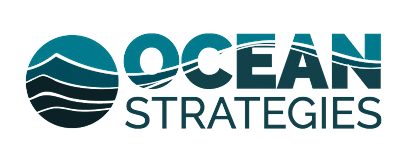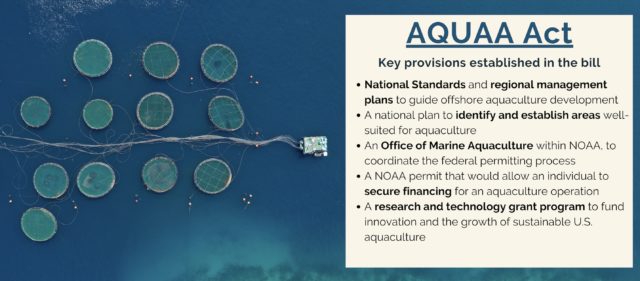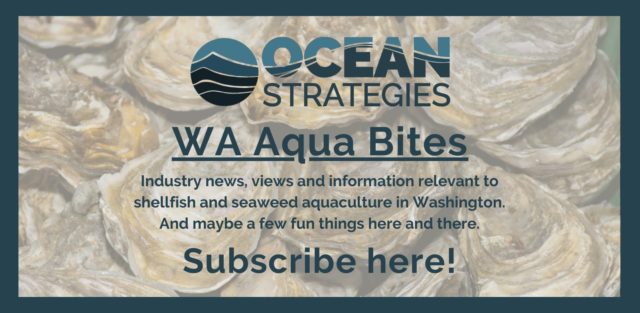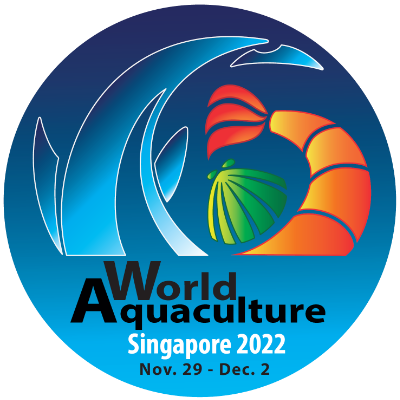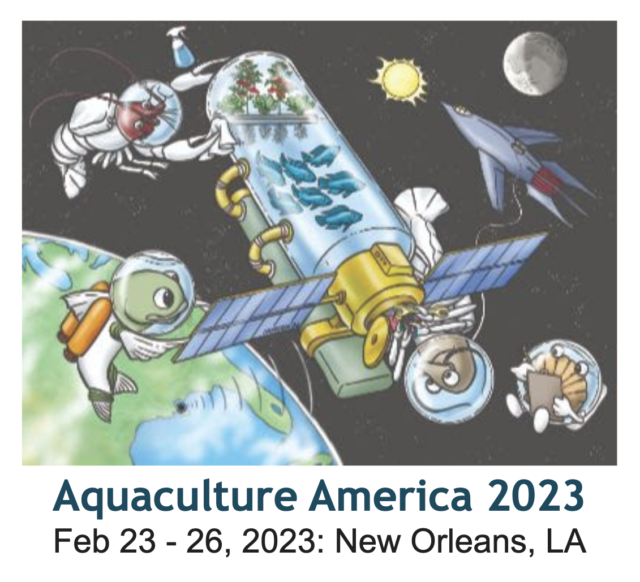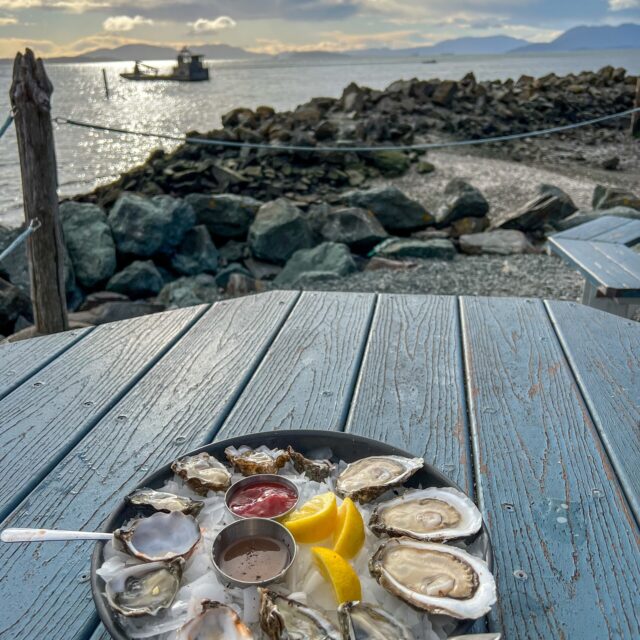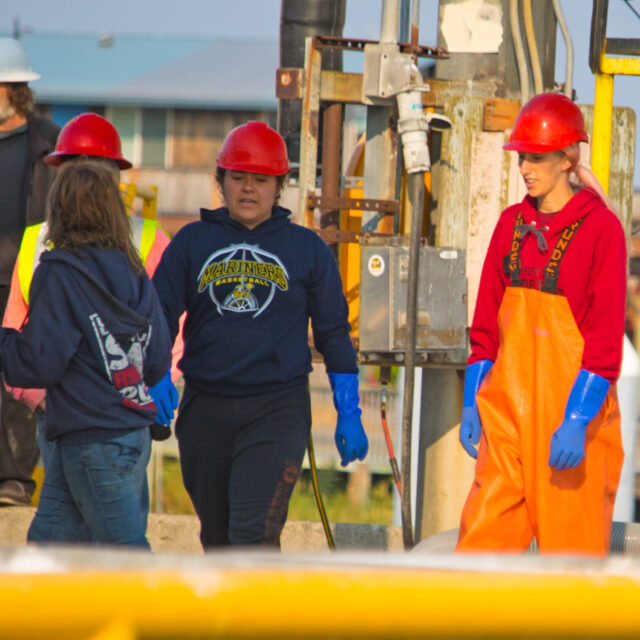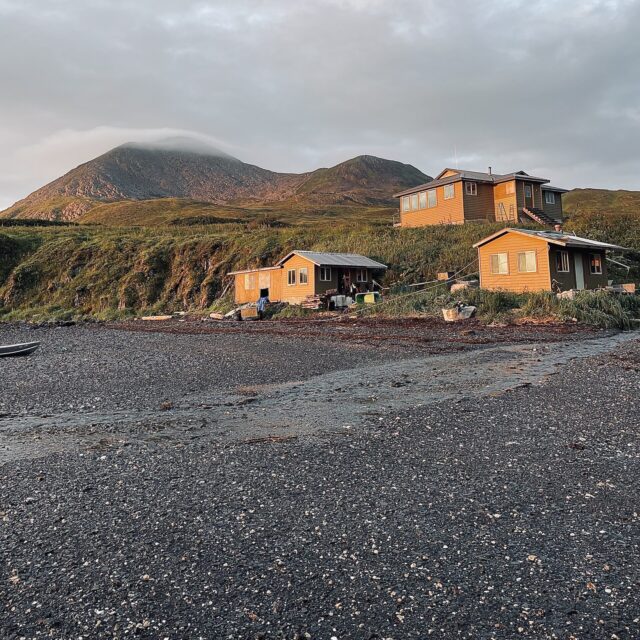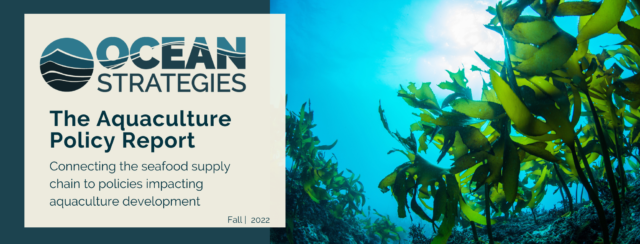
The Aquaculture Policy Report provides timely policy and industry updates connecting sectors across the seafood supply chain to aquaculture policy development. Unsubscribe below or sign up here.
America’s policy makers and industry experts are charting a course for the future of U.S. aquaculture, and we’re here to help track what affects you and your business. Supply chains and seafood communities nationwide have a stake in where and how aquaculture development happens and how we set standards and priorities. Keep reading for spotlights and opportunities.
WHAT WE’RE WATCHING IN FEDERAL AQUACULTURE POLICY
NOAA Announces 5-Year Strategic Plan for Aquaculture
Plan lays out framework to expand a resilient aquaculture industry
In late October NOAA announced their first 5-Year Strategic Plan for Aquaculture. It outlines a framework to “support a thriving, resilient, and inclusive U.S. aquaculture industry.” The vision is to advance the aquaculture industry in a way that increases access to domestic seafood and promotes healthy marine ecosystems — and stakeholder input along the way will be critical.
The NOAA Aquaculture Strategic Plan (2023–2028) includes four goals that outline NOAA’s priorities for sustainable growth.
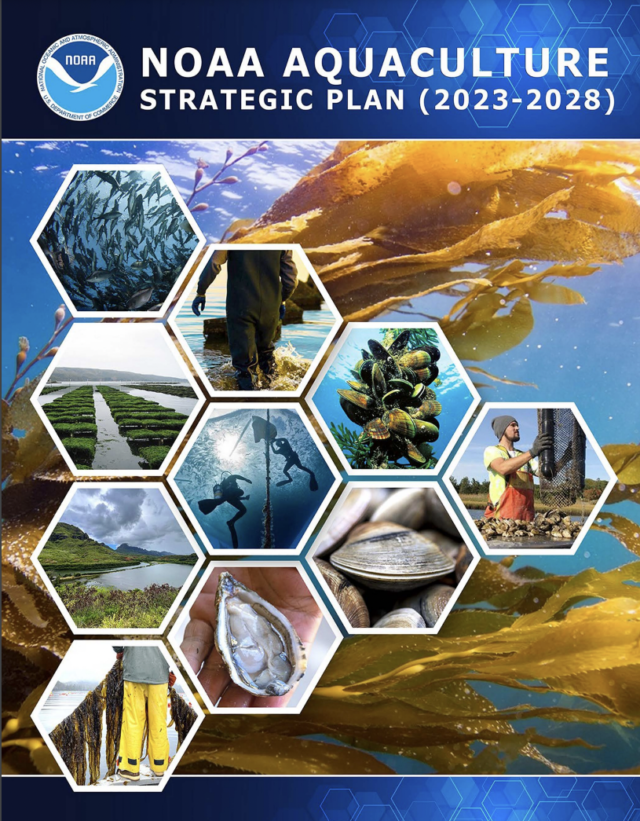 Manage Sustainably and Efficiently: Improve the regulatory processes for sustainable coastal and marine aquaculture through collaboration with partners.
Manage Sustainably and Efficiently: Improve the regulatory processes for sustainable coastal and marine aquaculture through collaboration with partners.-
Lead Science for Sustainability: Use world-class science expertise to meet management and industry needs for a thriving seafood production sector and share this knowledge broadly.
-
Educate and Exchange Information: Build awareness and support for coastal, marine, and Great Lakes aquaculture through two-way communication with diverse stakeholders and partners.
-
Support Economic Growth and Viability: Facilitate a robust aquaculture industry that thrives as a key component of a resilient seafood sector.
The NOAA Aquaculture Program consists of aquaculture offices from three agency offices: NOAA Fisheries, NOAA Sea Grant, and the National Centers for Coastal Ocean Science. Leaders have flagged community-driven results as an important factor in ongoing development. Current planning evolved with feedback from public listening sessions, and future work will prioritize additional opportunities for public input.
Stakeholder voices will be integral to the process of developing and expanding federal aquaculture opportunities, including representatives of America’s wild capture fisheries and seafood supply chain.
Update: Aquaculture Opportunity Areas
NOAA begins next step for aquaculture siting initiative
NOAA’s Aquaculture Program has now shifted efforts to assessing environmental impacts of the first two Aquaculture Opportunity Areas (named in August 2020) — areas deemed appropriate for developing offshore aquaculture resources. The formal process initiates an in-depth environmental evaluation of potential development with multiple opportunities for public input.
In May 2022, NOAA Fisheries announced its intent to prepare a Programmatic Environmental Impact Statement (PEIS) for Southern California, and the following month announced the same for the Gulf of Mexico. These announcements kicked off 60-day public scoping periods. Virtual public meetings were held throughout the summer where stakeholders could submit verbal comments on the PEIS process.
NMFS is currently reviewing all comments that were received and developing a public scoping summary.
The AOA initiative began with a Trump-era executive order in May 2020. Each step in the process incorporates a public comment period:
-
Within a year of the EO: Identify at least two geographic areas, in federal and/or state waters, suitable for commercial aquaculture. DONE.
-
In August 2020, the agency named the Gulf of Mexico and Southern California, and opened a 60-day public comment period in October 2020.
-
-
Within two years of IDing those areas: Complete a National Environmental Policy Act PEIS for each area. IN PROGRESS
-
Prior to beginning the PEIS process, NOAA laid out AOA Atlases for both areas in November 2021.
-
-
In the following four years: Identify two additional areas each year and complete a PEIS for each within two years, for a total of at least 10 areas over the course of five years. STILL TO COME
So far, NOAA’s AOA initiative has received mostly broad support from diverse stakeholder groups as science-based and stakeholder driven. As the agency moves through the steps to expand aquaculture projects in domestic waters, stakeholder input throughout the supply chain will be critical to developing aquaculture investment that complements and expands our existing sustainable seafood chain, through environmentally and socially responsible development.
Bipartisan Aquaculture Caucus formed in the House
The U.S. House of Representatives introduced the House Aquaculture Caucus in early October, with the purpose to educate Congress about the economic opportunities of a more robust domestic aquaculture industry. The Caucus intends to share policy updates, resources, and initiatives and work toward making U.S. aquaculture more competitive globally.
The Caucus is made up of a total of 13 Congressional representatives and will be co-chaired by Reps. Kat Cammack (R-FL), Ed Case (D-HI), Jimmy Panetta (D-CA), and Steven Palazzo (R-MS).
The creation of the Caucus was applauded by industry coalition Stronger America Through Seafood (SATS).
AQUAA Act reintroduction
Industry coalition announces new cosponsors of bill
In September, Stronger America Through Seafood (SATS) announced a list of new cosponsors for the Advancing the Quality and Understanding of American Aquaculture Act (AQUAA Act). The new cosponsors include Representatives Kat Cammack (R-FL), Angie Craig (D-MN), Delegate Stacey E. Plaskett (D-VI-At Large), and Senator Jerry Moran (R-KS).
Situational Summary: Congressional members took a third swipe toward comprehensive aquaculture policy last year. The Advancing the Quality and Understanding of American Aquaculture Act (AQUAA Act) was reintroduced in the Senate on October 28, 2021 by Senators Roger Wicker (R-MS), Brian Schatz (D-HI), and Marco Rubio (R-FL). This bipartisan bill would establish regulations to advance aquaculture development in U.S. federal waters. The main provisions of the bill include aquaculture siting, permitting, monitoring and enforcement. This is the third time the bill has been introduced in Congress, and this iteration is identical to its previous version, causing pause for opponents that express concern over offshore aquaculture’s impact on the marine environment and the health and sustainability of wild-capture fisheries.
Commercial fishermen want more information and analysis on what happens to seafood markets when flooded with new product, reminiscent of farmed salmon’s introduction in the 80’s and 90’s. Alaska’s seafood industry and fisheries stakeholders, a seafood political juggernaut, are adamant about a state’s right to opt-out of federal aquaculture, which was not included in this recent bill.
Proponents of the bill applaud the regulations it has laid out, as they state a major hindrance for the aquaculture industry’s responsible expansion has been the lack of a comprehensive regulatory framework and the many uncertainties within the permitting process. Supporters of increased domestic aquaculture production claim it will lead to less reliance on foreign seafood imports and therefore more food security for Americans. They also state the economic opportunity associated with aquaculture expansion, and how it will allow for the growth of other industries such as agriculture (feed production), manufacturing, and food processing and service. Working waterfronts also stand to benefit from increased activity and industry.
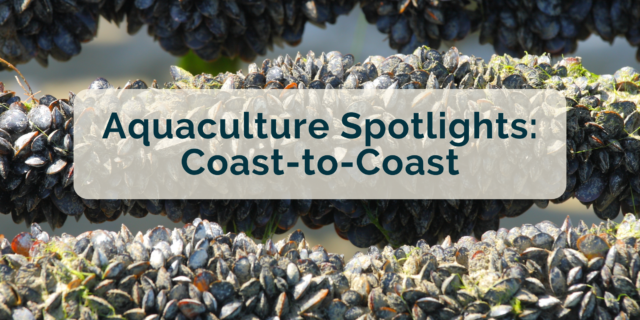
North Pacific
Alaska mariculture industry momentum continues to surge with new $49 million grant
The Alaska Mariculture Cluster, a coalition managed by Southeast Conference, has received major funding from the Build Back Better Regional Challenge (funded by the American Rescue Plan). The coalition was awarded a total of $49 million to help support Alaska’s growing mariculture industry.
Learn more about the Alaska Mariculture Cluster projects here.
Alaska Mariculture Alliance: a successor group to former Alaska Governor Bill Walker’s Alaska Mariculture Task Force (reauthorized in 2018 by Governor Mike Dunleavy), administered by the Alaska Fisheries Development Foundation. Its mission is to “develop and support a robust and sustainable mariculture industry, producing shellfish and aquatic plants for the long-term benefit of Alaska’s economy, environment and communities.”
Ocean Strategies is a proud associate member of the Alaska Mariculture Alliance.
West Coast
Washington DNR cancels Cooke Aquaculture permits, bans finfish farming in state waters
On Friday, November 18th, Washington State Department of Natural Resources Commissioner Hilary Franz issued an Executive Order banning all finfish farming in state waters. Citing ecological concerns to local salmon populations and the 2017 Cyprus Island netpen disaster, Commissioner Franz’s EO cancels Cooke Aquaculture’s steelhead leases. Washington follows other states like Alaska, Oregon and California, which also ban finfish farming in state waters. Learn more: Seattle Times and Cooke Aquaculture statement.
Sea cucumber aquaculture gets growing in Hawaiian fishponds
Kaua’i Sea Farms, in partnership with the Pacific American Foundation, is using a solar-powered hatchery to raise loli (Hawaiian sea cucumber) in their Hawaiian fishpond. The project is funded by NOAA and has the goal to grow loli as a high-value export product. The species will also help restore and revitalize the fishpond environment.
New England
Maine implements program to help train fishermen in aquaculture
Registration has opened for the “Aquaculture in Shared Waters” training program. The program, hosted by Maine Sea Grant, Coastal Enterprises, Inc, Main Aquaculture Association, and the Maine Aquaculture Innovation Center, is designed for commercial fishermen and focuses on the farming of shellfish and seaweed. Aquaculture has helped some fishermen diversify their income on Maine’s working waterfronts.
Breeding saltwater fish in public aquariums
The North Carolina Aquarium is one of seven facilities to receive a NOAA grant to advance the sustainability of breeding saltwater fish species and increase public awareness about aquaculture. Aquariums and universities are working together to build a network in which to advance aquaculture strategies for their breeding programs. Aquaculture can help provide aquariums a sustainable way to populate their animal habitats.
Check out this award winning article from the Carolina Press about the North Carolina oyster trail: Oyster trail designed to protect threatened industry
Washington State
ICYMI: Ocean Strategies releases newest WA Aqua Bites newsletter
The Ocean Strategies team has been keeping our ear to the ground regarding all things Washington aquaculture. Our quarterly newsletter, WA Aqua Bites, informs the seafood supply chain of important aquaculture happenings in Washington and beyond. Subscribe below.
WOMEN IN AQUA, WORKSHOPS & WHAT’S AHEAD
Women who lead
Check out this inspiring article that highlights women leaders in U.S. aquaculture and the diverse leadership approaches they are taking to show how the benefits of aquaculture can help earn the industry the social license to operate.
Establishing more female and diverse representation throughout the seafood industry is a vital component to ensure an environmentally, socially and economically sustainable supply chain.
Most importantly, diversity in leadership is a demonstrated strategy for creating a more resilient and thriving business and industry. Incorporating the skill and expertise of women into seafood industry leadership and decision-making positions, especially as it relates to discussions around climate issues and seafood-related policies, helps us to achieve a viable and thriving food production system.
Multisector Aquaculture Design Workshop: Charting an Inclusive Future for U.S. Seafood Production
Check out this article, authored by Meridian Institute’s Meghan Massaua and Madelyn Smith, which provides a synopsis of the workshop as well as the Workshop Design Summary Report.
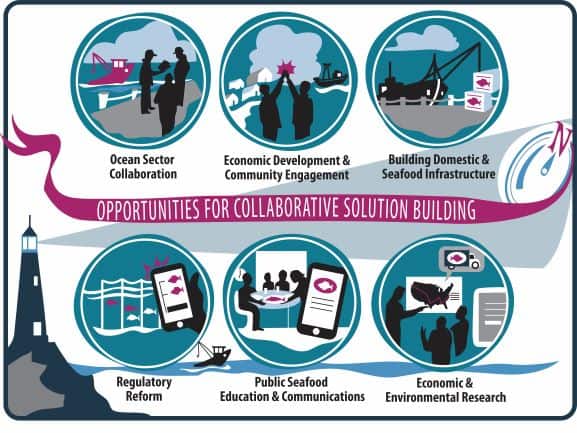
Bright horizons: Seaweed and shellfish 2023 outlook
This article from Aquaculture North America highlights the strong future ahead for seaweed and shellfish farming and what to expect as the mariculture industry sees its day.
“That [positive] reputation is well deserved and will serve the [seaweed and shellfish farming] industry well as operations grow larger because, though exhausted from Covid, these farmers are pragmatic, smart, and not likely to be satisfied with the status quo. They’ve looked up from the mudflats and see new things on the horizon.”
EVENTS & OPPORTUNITIES
Ocean Strategies will be releasing our Fall Fisheries Policy Report and a special edition Equity in U.S. Fisheries Report in the coming weeks. Stay tuned!
